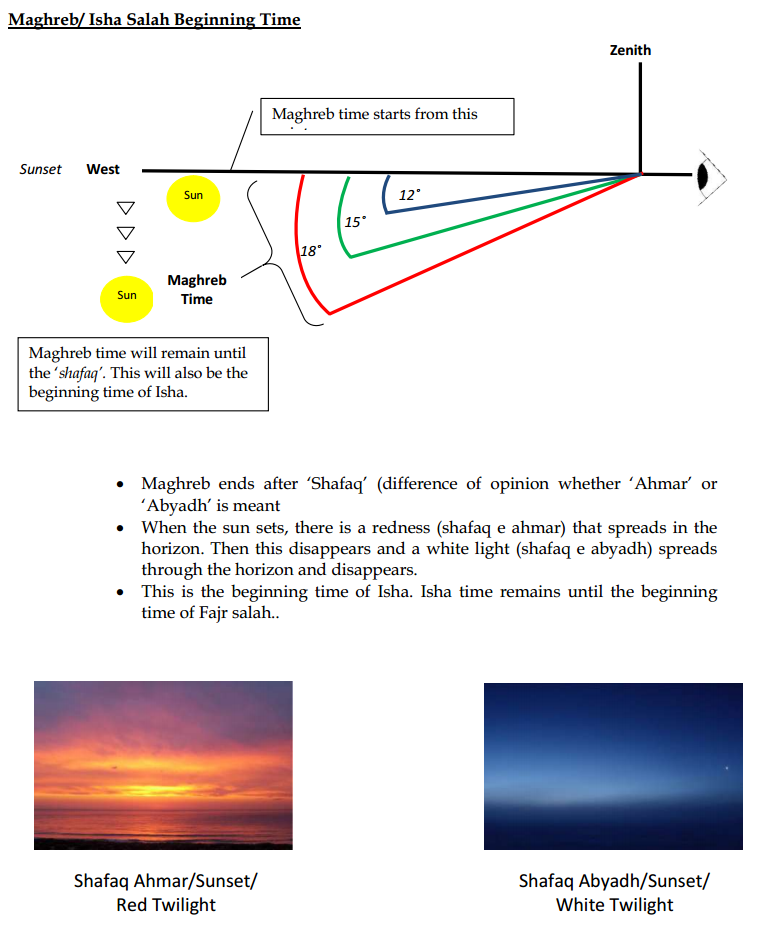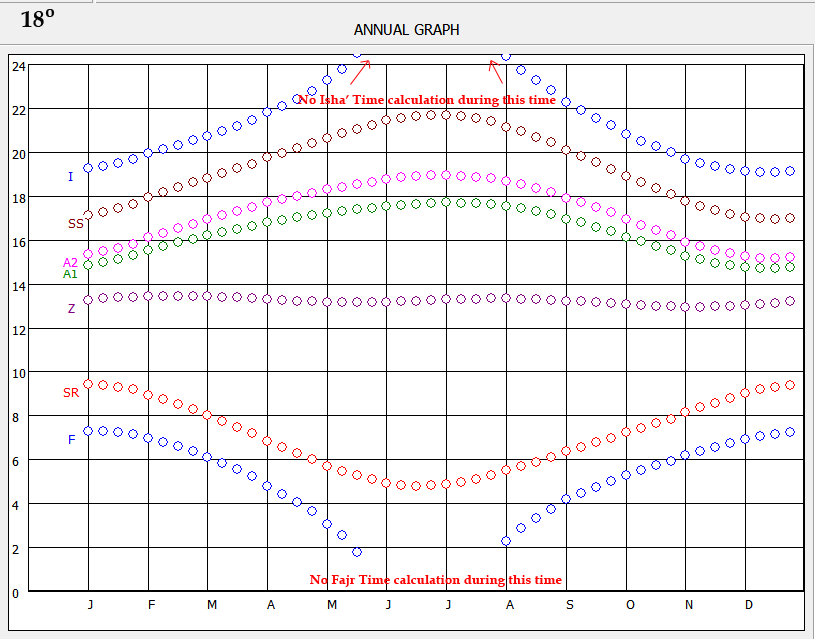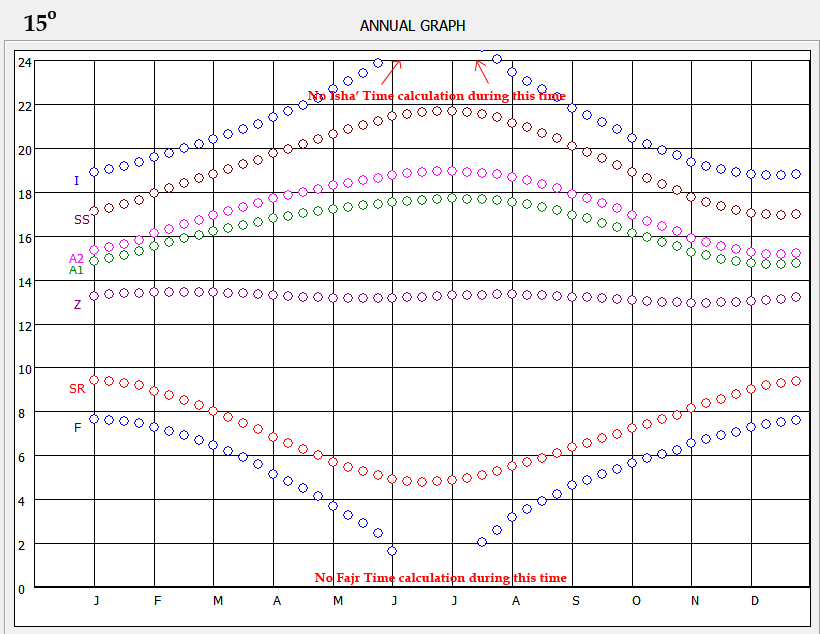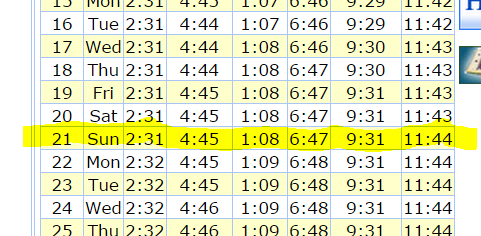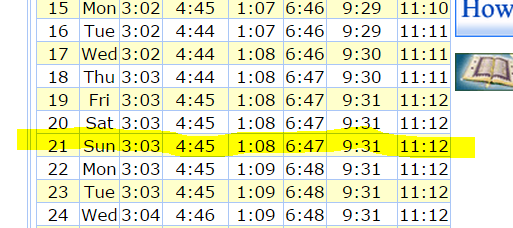Isha’ Salah Timings for North Battleford (52.8˚ N)
Isha’ Times at higher latitude for North Battleford
1. What is the earliest time for Isha ?
Commencement of Isha’ time is linked with the ending time of Maghreb Salah. All the Imams rahimahumullah are agreed upon this point. Their difference arises in the establishment of end-time of Maghrib Salah. The two famous students of Imam al A’dham namely Imam Abu Yusuf and Imam Muhammad al Shaybani rahimahullah along with Imam Malik , Imam Shafi’i and Imam Ahmed ibn Hanbal rahimahumullah ta’ala are all of the opinion that the end time for Maghreb is when the reddish glow/twilight (Shafaq al Ahmar) disappears. In contrast to these Imam Abu Hanifa rahimahullah opined that the end time for Maghreb is when the white glow/twilight (Shafaq Abyad) disappears. [1]
Based on the above difference of opinion, the starting time for Isha’ will also differ. In contemporary discussion the biggest challenge has been formulating these two twilights (red and white) into a calculative method. Many of the contemporary scholars have adopted the direct correlation between the level of illumination and the depression of sun below the horizon. These are then calculated in the form of amount of degree sun has dipped below horizon. Thus far, the classic difference of opinion translated into red twilight being assigned 15˚ and white twilight 18˚ respectively.
Ilustratively, let us see the following diagram:
While such formulation does provide us with considerable command over standardizing the salah calculation, multiple factors remain challenging for those who avidly wish to follow original stance of sighting (Mushahadah) to their level best. For example, while contemporary methodology affixes 18˚ for the white twilight, those of knowledge are well aware that
a. Twilight in actual fact refers to a band or a range and the disappearance of twilight could occur within that range depending on different factors.
b. Disappearance of twilight is not a singular moment rather a diffusion of the remaining light within the atmosphere. Quantifying this with a linear formula is exceptionally difficult.
The result of this expresses in a wide array of opinions. In short the earliest time for Salah under normal circumstances will be at the disappearance of Red-Twilight (15˚). Care must be taken while implementing 15˚ for Salah calculations that Maghreb Salah beyond this point will have to be made Qadha’. [2]
2. So, can we just use 15˚ for our Isha’ calculation?
First and foremost, it should be notes that the “White Twilight disappearance” which is Imam Abu Hanifah rahimahullah’s opinion (i.e 18˚ position) is most cautious of the oipinion. Whenever, and wherever this opinion can be followed without undue distress, it should be preferred. The challenges of Salah calculations mentioned in #1 are compounded at higher latitude areas like North Battlefords. In fact, any place beyond 48.5˚N latitude will experience some days or even weeks within the year where the White Twilight (18˚) will not even disappear. Moreover, similar number of cities (beyond 51.5˚N) also experience days on end where even the Red Twilight (15˚) would remain on the sky throughout the night without disappearing. These are indeed abnormal zones which require rigorous thought for establishing their Salah times. If the Red Twilight remains on the sky, then technically Isha’ time does not even enter. Hence, we resort to making some form of Ijtihad in this instance to establish our Salah time.
3. How can that be when Islamic-finder gives us these timings for 15˚ as well as 18˚?
Islamic-Finder is globally used for Salah times. However, as widespread and common Islamic-finder is, its calculations for higher latitude areas are wrong and deceiving. In the past I have tried multiple times to contact Islamic-finder to ask about their criteria for changing these calculations for both 15˚ and 18˚, and still displaying them as though they were regular timings. I presume that they are using some form of normalization for the abnormal higher latitudes and skewing their output. This would not be a problem if they detail out their criteria so we can assess if it is correct or not.
To understand better let us look at some examples. The calculations given by Islamic-Finder for the longest day of the year (i.e June 21st ) for both the methods are as follows:
Islamic – Finder : Calculated according to 18˚ for Fajr & Isha’ | ||||||
Fajr | Sunrise | Dhuhr | Asr | Maghreb | Isha’ | |
June 21, Sun | 2:31 | 4:45 | 1:08 | 6:47 | 9:31 | 11:44 |
Islamic – Finder : Calculated according to 15˚ for Fajr & Isha’ | ||||||
June 21, Sun | 3:03 | 4:45 | 1:08 | 6:47 | 9:31 | 11:12 |
Let us contrast the above times with the ones provided by two leading personalities in the field of astronomical calculations below:
Dr. Monzur Ahmed prepared one of the oldest prayer calculation software. His software output shows :
Prayer Time Calculator by Dr. Monzur Ahmed : Calculated according to 18˚ for Fajr & Isha’ | ||||||
Fajr | Sunrise | Dhuhr | Asr | Maghreb | Isha’ | |
June 21, Sun | ??:?? | 4:48 | 1:17 | 6:55 | 9:41 | ??:?? |
Prayer Time Calculator by Dr. Monzur Ahmed : Calculated according to 15˚ for Fajr & Isha’ | ||||||
June 21, Sun | ??:?? | 4:48 | 1:17 | 6:55 | 9:41 | ??:?? |
In the above ??:?? indicates that there is no actual output for the specified time. This is in fact the case since on June 21, the sun does not even dip below 15˚.
Another similar astronomer who has worked on prayer calculations is Dr. Khalid Showkat. He also provided me with real un-edited calculations for Salah times for North Battleford. His table gives the following readings.
Dr. Khalid Showkat : Calculated according to 18˚ for Fajr & Isha’ | ||||||
Fajr | Sunrise | Dhuhr | Asr | Maghreb | Isha’ | |
June 21, Sun | —- | 4:48a | 1:20p | 6:56p | 9:45p | —- |
Dr. Khalid Showkat : Calculated according to 15˚ for Fajr & Isha’ | ||||||
June 21, Sun | —- | 4:48a | 1:20p | 6:56p | 9:45p | —- |
Just like the previous one, “—-“ indicates towards no output reading.
A graphical visualization of this is demonstrated in the diagram below
According to 18˚:
According to 15˚:
Also note that Islamic-finder output readings for “North Battleford” for sunset are considerably different than the rest. The readings for sunset are more inline with other calculating authorities (like timeanddate & sunrisesunset etc) if we choose “Battleford” in Islamic-finder. In conclusion, Islamic-finder has been proven to be inaccurate, especially for higher latitude areas. Since we are calculating times for our Salaat, an integral ibaadah (worship), I would not recommend a half-baked algorithmic calculation which has proven to be incorrect multiple times.
4. So how do we then calculate our Isha’ times?
While tackling this problem one must keep in mind that such issues did not appear before Rasulullah r , hence we do not have a direct and unambiguous resolution for such a situation in Sunnah. However, as per the dictate of usool al fiqh, we draw help from the injunctions of Qiyas (analogy) and Ijtihad to seek resolution to our problem. Since analogical deductions are dhanni (theoretical) in nature, there is a big scope of array of opinions to emanate from it.
For instance, while discussing such a situation in the past, some scholars have even postulated the view that a place where the signs of entry of a particular Salah does not manifest, the obligation of Salah itself is not established and one does not need to pray Isha’ in such instance. As minor an opinion this maybe, academic honesty demands to recognize the possibility of different opinions to arise in the ambits of analogical deductions.[5]
Contemporary scholars have mentioned a few ways to tackle the absence of entry-time for Isha’. All these methods are equally acceptable for implementation.[6] These include:
1. Aqrabul ayyām: This is to set the time of Isha’ according to the last day when the time of Isha was present and to use that time throughout this period. [7]
2. Aqrabul bilād: This is to follow and implement the salah timings of the closest neighbouring city in which the time of Isha’ is present.[8] [9]
3. Nisful layl: The time between sunset and sunrise is divided into two parts. The first half is considered to be night and the second morning, meaning the time for Isha’ will end (and the time for Fajr will commence) when the first half comes to an end.
4. Sab’ul layl: The time between sunset and sunrise is divided into seven parts. The first parts is considered to be Maghreb time, second five parts are considered as Isha’ time, and the final part is considered to be the commencement for Fajr Salah (Subh Sadiq).[10]
5. Jama’ bayn as Salah: Either pray Isha and witr after Subh Sādiq before Fajr salah with adhaan and Takbeer[11], or Perform Isha’ Salah after Maghreb Salah[12]
After reviewing these methods, I have come to the conclusion that:
a. The Jama’ bayn as Salah (combining prayers) is a practice which a few contemporary scholars have implemented. In my view, it is not the most suitable choice for most of our cities. I say this for the following reasons:
i. The practice is not widely accepted by traditional scholars even in hypothetical sense. Schools of Imam Malik, Shafi’i and Ahmed rahimahumullah allow combining salaat with very specific conditions for its eligibility.
ii. The primary basis for combining prayers by these contemporary scholars is the narration where Rasulullah r combined prayers without any excuse. Even by standards of traditional scholar like Imam Nawawi rahimahullah the combining of prayers remains very restrictive. He mentions clearly that no school has adopted combining prayers when there is no shar’i excuse. This presents us with a challenge of applying such a Qiyas to an entire summer in abnormal zones, where the actual shar’i excuse materializes for half the time. The maxim, “necessity only eases (the prohibited) to the extent of the need” demands that if we choose this option, then we must only apply to those days when twilight does not fade at all.
iii. For North Battleford, this would mean applying this method for June 3rd to July 10th.
iv. Moreover, it would not really resolve our problem since before June 3rd and after July 10th the timings for salah will remain very late for Isha’ and very early for Fajr.
v. The other option is to invoke the clause of “Haraj” and broaden the combining of prayers to include entirety of April as well as August. In my humble opinion, this is stretching the limits of haraj to great level and without much need. (I shall explain below)
b. Options 1, 2, 3 also suffer from the same problem as expressed above in a(iii,iv,v). These options will not solve the impending challenge of extreme times. They will simply aid in getting a “time” to offer salah, but not necessary ward off the “haraj” from the congregants.[13]
c. Hence with all my will, I have exerted myself and come to conclusion that a good balance is achieved in #4 i.e Sab’ul Layl. The reasons for my choice is because:
i. The calculation method for this is easily discernible.
ii. It emulates the injunction of “estimating” the salah times for abnormal zones more rationally than all other methods.
iii. It is echoed by multiple traditional scholars from different school of thoughts including Shafi’iyyah as well as Hanafiyyah.
iv. It also retains the general sequence and appearance of five distinctive salah times. This may seem as a redundant aspect, yet I have found that it leaves a very healthy psychological condition for regular congregants.
v. The outcome of Sab’ul Layl can be stretched to include all the months from April up till end of August (summer months) without showing much deviation from regular times.
vi. The breakeven point between 18˚/15˚ and 1/7th method is approximately at 10:00PM. This means that this method only affects the Salah after its time goes beyond 10PM which is a viable cut-off time for haraj.
vii.Sab’ul Layl offers an approximate difference of about 1 hour to 1hr 5~15 min.
An example for Sab’ul Layl timings for June 21st (longest day) is as follows:
| Fajr | Sunrise | Dhuhr | Asr(S) | Asr(H) | Maghreb | Isha’ | ||
| 21-Jun | Mon | 2:45 | 4:48 | 13:20 | 17:41 | 18:56 | 21:40 | 22:43 |
In conclusion, while combining prayers does have a basis among contemporary scholars yet I do not feel that it is a solution to the problem. It is quite possible that another scholar may opt this option viewing the demographics and dynamics of his congregants.
Please also take special note that this entire discussion is in regards to Isha’ timings for the abnormal zones and does not reflect equally onto the Fajr timings. Timings for Fajr require an equally important review. In short, Fajr timings are hinged upon the occurrence of Subh Sadiq, which unlike dispersion of twilight is a singular event of high illumination over the horizon. Hence, as long as a valid reading of Subh Sadiq is found, we cannot extend leeway of varying degree calculations to it. In recent observations throughout Canada this value of Subh Sadiq has materialized close to 18˚. Until there is a local observation for the particular city, I cannot recommend anything except the cautious opinion of following 18˚ and utilizing Aqrab al Ayyam for the abnormal days. This is reflective in the chart prepared for North Battleford.
I hope the attached timings for Salah will help the Muslim Community to adhere to our worship, without undue hardship and at the same time being closely linked to the classical and traditional understanding of Islamic Jurisprudence.
May Allah help and assist us all, Ameen.
Wallahu A’lam,
Wassalamu Alaikum Warahmatullah,
Mufti Faisal bin Abdul Hameed,
Darul Iftaa Canada
www.fatwa.ca
و وقت المغرب منه الى غروب الشفق الاحمر على المفتى به(نور الايضاح , ص. ٤٤, مكتبة العصرية)
و وقت المغرب منه الى غروب الشفق وهو الحمرة عندهما وبه قال الثلاثة واليه رجع الامام كما في شروح المجمع وغيرها فكان هو المذهب (رد المحتار , ج. ٢, ص. ١٧, دار عالم الكتب)
وَأَوَّلُ وَقْتِ الْعِشَاءِ حِينَ يَغِيبُ الشَّفَقُ وَاخْتَلَفُوا فِي تَفْسِيرِ الشَّفَقِ، فَعِنْدَ أَبِي حَنِيفَةَ هُوَ الْبَيَاضُ، وَهُوَ مَذْهَبُ أَبِي بَكْرٍ وَعُمَرَ وَمُعَاذٍ وَعَائِشَةَ ء رَضِيَ اللَّهُ عَنْهُمْ ء، وَعِنْدَ أَبِي يُوسُفَ وَمُحَمَّدٍ وَالشَّافِعِيِّ هُوَ الْحُمْرَةُ، وَهُوَ قَوْلُ عَبْدِ اللَّهِ بْنِ عَبَّاسٍ وَعَبْدِ اللَّهِ بْنِ عُمَرَ ء رَضِيَ اللَّهُ عَنْهُمْ ء وَهُوَ رِوَايَةُ أَسَدِ بْنِ عَمْرٍو عَنْ أَبِي حَنِيفَةَ. (بدائع الصنائع, ج.١, ص. ٣٢١, مكتبة رشيدية)
واخر وقت المغرب حتى يغيب الشفق. وأول وقت العشاء حين يغيب الشفق واخر وقتها يمتد الى طلوع الفجر. وتفسير الشفق في قول أبي حنيفة رحمه الله البياض، وفي رواية أسد بن عمرو أنه الحمرة، وهو قول أبي يوسف ومحمد والشافعي (المحيط البرهاني, ج.٢, ص.٦, ادارة القران)
قلت أَرَأَيْت الْمغرب مَتى هُوَ قَالَ من حِين تغرب إِلَى أَن يغيب الشَّفق قلت وَتكره أَن يؤخرها إِذا غَابَ الشَّفق قَالَ نعم والشفق الْبيَاض الْمُعْتَرض فِي الْأُفق فِي قَول أبي حنيفَة وَفِي قَول أبي يُوسُف وَمُحَمّد الْحمرَة وروى أَيْضا عَن أبي حنيفَة أَنه قَالَ الشَّفق هُوَ الْحمرَة (الأصل المعروف بالمبسوط, ج.١, ص.١٤٥, ادارة القران)
(قَوْلُهُ: وَمَنْ لَمْ يَجِدْ وَقْتَهُمَا لَمْ يَجِبَا) أَيْ الْعِشَاءُ وَالْوِتْرُ كَمَا لَوْ كَانَ فِي بَلَدٍ يَطْلُعُ فِيهِ الْفَجْرُ قَبْلَ أَنْ يَغِيبَ الشَّفَقُ كَبُلْغَارَ وَفِي أَقْصَرِ لَيَالِي السَّنَةِ فِيمَا حَكَاهُ مُعْجَمُ صَاحِبِ الْبُلْدَانِ لِعَدَمِ السَّبَبِ وَأَفْتَى بِهِ الْبَقَّالِيُّ كَمَا يَسْقُطُ غَسْلُ الْيَدَيْنِ مِنْ الْوُضُوءِ عَنْ مَقْطُوعِهِمَا مِنْ الْمِرْفَقَيْنِ، وَأَفْتَى بَعْضُهُمْ بِوُجُوبِهَا وَاخْتَارَهُ الْمُحَقِّقُ فِي فَتْحِ الْقَدِيرِ بِثُبُوتِ الْفَرْقِ بَيْنَ عَدَمِ مَحَلِّ الْفَرْضِ وَبَيْنَ سَبَبِهِ الْجَعْلِيِّ الَّذِي جُعِلَ عَلَامَةً عَلَى الْوُجُوبِ الْخَفِيِّ الثَّابِتِ فِي نَفْسِ الْأَمْرِ وَجَوَازُ تَعَدُّدِ الْمُعَرِّفَاتِ لِلشَّيْءِ فَانْتِفَاءُ الْوَقْتِ انْتِفَاءُ الْمُعَرِّفِ وَانْتِفَاءُ الدَّلِيلِ عَلَى الشَّيْءِ لَا يَسْتَلْزِمُ انْتِفَاءَهُ لِجَوَازِ دَلِيلٍ آخَرَ وَهُوَ مَا تَوَاطَأَتْ عَلَيْهِ أَخْبَارُ الْإِسْرَاءِ مِنْ فَرْضِ اللَّهِ الصَّلَاةَ خَمْسًا إلَى آخِرِهِ وَالصَّحِيحُ (البحر الرائق شرح كنز الدقائق ومنحة الخالق وتكملة الطوري (1/ 259))… ((قَوْلُهُ: وَاخْتَارَهُ الْمُحَقِّقُ فِي فَتْحِ الْقَدِيرِ إلَخْ) أَقُولُ: رَدَّهُ الْعَلَّامَةُ الْحَلَبِيُّ شَارِحُ الْمُنْيَةِ وَوَافَقَهُ الْعَلَّامَةُ الْبَاقَانِيُّ فِي شَرْحِهِ عَلَى الْمُلْتَقَى وَالشُّرُنْبُلاليّ فِي إمْدَادِ الْفَتَّاحِ وَحَوَاشِيهِ عَلَى الدُّرَرِ وَالْعَلَّامَةُ نُوحٌ أَفَنْدِي فِي حَاشِيَةِ الدُّرَرِ وَكَذَا أَخُو الْمُؤَلِّفِ فِي نَهْرِهِ وَتَابَعَهُمْ الشَّيْخُ عَلَاءُ الدِّينِ الْحَصْكَفِيُّ فِي شَرْحِهِ عَلَى التَّنْوِيرِ وَلَكِنْ انْتَصَرَ لِلْمُحَقِّقِ ابْنُ الْهُمَامِ فَلْيُتَدَبَّرْ شَرْحُ التَّنْوِيرِ شَيْخُ مَشَايِخِنَا الْعَلَّامَةُ الشَّيْخُ إبْرَاهِيمُ الْحَلَبِيُّ الْمَدَارِيُّ وَرَدَّ كَلَامَ شَارِحِ الْمُنْيَةِ فِي حَاشِيَتِهِ وَكَتَبْت فِي هَامِشِهِ مَا يَدْفَعُ جَوَابَهُ بِأَظْهَرِ وَجْهٍ وَأَبْيَنِهِ فَلْيُرَاجَعْ ذَلِكَ) (منحة الخالق وتكملة الطوري (1/ 259))
(قَوْلُهُ: فَإِنَّ فِيهَا يَطْلُعُ الْفَجْرُ قَبْلَ غُرُوبِ الشَّفَقِ) مُقْتَضَاهُ أَنَّهُ فُقِدَ وَقْتُ الْعِشَاءِ وَالْوِتْرِ فَقَطْ وَلَيْسَ كَذَلِكَ، بَلْ فُقِدَ وَقْتُ الْفَجْرِ أَيْضًا؛ لِأَنَّ ابْتِدَاءَ وَقْتِ الصُّبْحِ طُلُوعُ الْفَجْرِ، وَطُلُوعُ الْفَجْرِ يَسْتَدْعِي سَبْقَ الظَّلَامِ وَلَا ظَلَامَ مَعَ بَقَاءِ الشَّفَقِ أَفَادَهُ ح.
أَقُولُ: الْخِلَافُ الْمَنْقُولُ بَيْنَ مَشَايِخِ الْمَذْهَبِ إنَّمَا هُوَ فِي وُجُوبِ الْعِشَاءِ وَالْوِتْرِ فَقَطْ، وَلَمْ نَرَ أَحَدًا مِنْهُمْ تَعَرَّضَ لِقَضَاءِ الْفَجْرِ فِي هَذِهِ الصُّورَةِ، وَإِنَّمَا الْوَاقِعُ فِي كَلَامِهِمْ تَسْمِيَتُهُ فَجْرًا؛ لِأَنَّ الْفَجْرَ عِنْدَهُمْ اسْمٌ لِلْبَيَاضِ الْمُنْتَشِرِ فِي الْأُفُقِ مُوَافِقًا لِلْحَدِيثِ الصَّحِيحِ كَمَا مَرَّ بِلَا تَقْيِيدٍ بِسَبْقِ ظَلَامٍ. عَلَى أَنَّا لَا نُسَلِّمُ عَدَمَ الظَّلَامِ هُنَا، ثُمَّ رَأَيْت ط ذَكَرَ نَحْوَهُ.
(قَوْلُهُ: فِي أَرْبَعِينِيَّةِ الشِّتَاءِ) صَوَابُهُ فِي أَرْبَعِينِيَّةِ الصَّيْفِ كَمَا فِي الْبَاقَانِيِّ. وَعِبَارَةُ الْبَحْرِ وَغَيْرِهِ: فِي أَقْصَرِ لَيَالِيِ السَّنَةِ وَتَمَامُهُ فِي ح. وَقَوْلُ النَّهْرِ: فِي أَقْصَرِ أَيَّامِ السَّنَةِ سَبْقُ قَلَمٍ، وَهُوَ الَّذِي أَوْقَعَ الشَّارِحَ.
(قَوْلُهُ: فَيُقَدِّرُ لَهُمَا) هَذَا مَوْجُودٌ فِي نُسَخِ الْمَتْنِ الْمُجَرَّدَةِ سَاقِطٌ مِنْ الْمِنَحِ، وَلَمْ أَرَ مَنْ سَبَقَهُ إلَيْهِ سِوَى صَاحِبِ الْفَيْضِ، حَيْثُ قَالَ: وَلَوْ كَانُوا فِي بَلْدَةٍ يَطْلُعُ فِيهَا الْفَجْرُ قَبْلَ غَيْبُوبَةِ الشَّفَقِ لَا يَجِبُ عَلَيْهِمْ صَلَاةُ الْعِشَاءِ لِعَدَمِ السَّبَبِ، وَقِيلَ يَجِبُ وَيُقَدَّرُ الْوَقْتُ. اهـ.
بَقِيَ الْكَلَامُ فِي مَعْنَى التَّقْدِيرِ، وَاَلَّذِي يَظْهَرُ مِنْ عِبَارَةِ الْفَيْضِ أَنَّ الْمُرَادَ أَنَّهُ يَجِبُ قَضَاءُ الْعِشَاءِ، بِأَنْ يُقَدِّرَ أَنَّ الْوَقْتَ أَعْنِي سَبَبَ الْوُجُوبِ قَدْ وُجِدَ كَمَا يُقَدَّرُ وُجُودُهُ فِي أَيَّامِ الدَّجَّالِ عَلَى مَا يَأْتِي؛ لِأَنَّهُ لَا يَجِبُ بِدُونِ السَّبَبِ، فَيَكُونُ قَوْلُهُ وَيُقَدَّرُ الْوَقْتُ جَوَابًا عَنْ قَوْلِهِ فِي الْأَوَّلِ لِعَدَمِ السَّبَبِ.
وَحَاصِلُهُ أَنَّا لَا نُسَلِّمُ لُزُومَ وُجُودِ السَّبَبِ حَقِيقَةً بَلْ يَكْفِي تَقْدِيرُهُ كَمَا فِي أَيَّامِ الدَّجَّالِ. وَيَحْتَمِلُ أَنَّ الْمُرَادَ بِالتَّقْدِيرِ الْمَذْكُورِ هُوَ مَا قَالَهُ الشَّافِعِيَّةُ مِنْ أَنَّهُ يَكُونُ وَقْتَ الْعِشَاءِ فِي حَقِّهِمْ بِقَدْرِ مَا يَغِيبُ فِيهِ الشَّفَقُ فِي أَقْرَبِ الْبِلَادِ إلَيْهِمْ، وَالْمَعْنَى الْأَوَّلُ أَظْهَرُ، كَمَا يَظْهَرُ لَك مِنْ كَلَامِ الْفَتْحِ الْآتِي حَيْثُ أَلْحَقَ هَذِهِ الْمَسْأَلَةَ بِمَسْأَلَةِ أَيَّامِ الدَّجَّالِ (الدر المختار وحاشية ابن عابدين (رد المحتار) (1/ 362))
[6] All except combining of Maghreb and Isha’ since fuqaha’ from salaf have held rigorous restriction for those even if done due to haraj. A further review of this is explained ahead.
[7] According to this method we continue with the regular calculation for Isha’ and the day it stops giving outputs, we freeze it to that day. A point of clarification for this method is to understand the reduction in time on daily basis. For example in North Battleford, if we are opting for cautious 18˚ for Isha’, then from May 08, the isha’ timings will be as follows:
Date | Isha’ 18 | Difference | ||
Apr | 29 | Wed | 23:09 | |
Apr | 30 | Thu | 23:13 | 0:04 |
May | 1 | Fri | 23:17 | 0:04 |
May | 2 | Sat | 23:20 | 0:03 |
May | 3 | Sun | 23:25 | 0:05 |
May | 4 | Mon | 23:29 | 0:04 |
May | 5 | Tue | 23:33 | 0:04 |
May | 6 | Wed | 23:37 | 0:04 |
May | 7 | Thu | 23:42 | 0:05 |
May | 8 | Fri | 23:47 | 0:05 |
May | 9 | Sat | 23:52 | 0:05 |
May | 10 | Sun | 23:57 | 0:05 |
May | 11 | Mon | 24:03 | 0:06 |
May | 12 | Tue | 24:09 | 0:06 |
May | 13 | Wed | 24:15 | 0:06 |
May | 14 | Thu | 24:23 | 0:08 |
May | 15 | Fri | 24:31 | 0:08 |
May | 16 | Sat | 24:42 | 0:11 |
May | 17 | Sun | 25:04 | 0:22 |
May | 18 | Mon | ??:?? | ??? |
Similarly, if following the 15˚ opinion, we will freeze the Isha’ times on May 25th at 12:04PM and then resume on July 22nd at 12:04PM.
وَسُئِلَ الشَّيْخُ أَبُو حَامِدٍ عَنْ بِلَادِ بُلْغَارَ كَيْفَ يُصَلُّونَ فَإِنَّهُ ذُكِرَ أَنَّ الشَّمْسَ لَا تَغْرُبُ عِنْدَهُمْ إلَّا بِمِقْدَارِ مَا بَيْنَ الْمَغْرِبِ وَالْعِشَاءِ ثُمَّ تَطْلُعُ فَقَالَ: يُعْتَبَرُ صَوْمُهُمْ وَصَلَاتُهُمْ بِأَقْرَبِ الْبِلَادِ إلَيْهِمْ، وَالْأَحْسَنُ، وَبِهِ قَالَ بَعْضُ الشُّيُوخِ إنَّهُمْ يُقَدِّرُونَ ذَلِكَ وَيَعْتَبِرُونَ اللَّيْلَ وَالنَّهَارَ، كَمَا قَالَ – صَلَّى اللَّهُ عَلَيْهِ وَسَلَّمَ – فِي يَوْمِ الدَّجَّالِ الَّذِي كَسَنَةٍ وَكَشَهْرٍ: «اُقْدُرُوا لَهُ» حِينَ سَأَلَهُ الصَّحَابِيُّ عَنْ الصَّوْمِ وَالصَّلَاةِ فِيهِ (حاشية البجيرمي على الخطيب = تحفة الحبيب على شرح الخطيب (1/ 394))
[9] The method of utilizing Aqrab al bilad is to use the longitude of the particular target city. For instance for North Battleford we will take its longitude, which is 108.29W. Now keeping the same longitude we move down to lower latitude to such a city which has normal zone throughout the year. In our case it would be approximately 48.5N and 108.29W. With reverse lookup this gives us Dodson, MT in United States. See below:
(قَوْلُهُ قَدْرَ مَا يَغِيبُ الشَّفَقُ فِي مِثْلِهِ) أَيْ قَدْرُهُ بِاعْتِبَارِ نِسْبَتِهِ إلَى لَيْلِهِمْ، فَإِذَا كَانَ وَقْتُ الْمَغْرِبِ عِنْدَ مَنْ يَغِيبُ شَفَقُهُمْ سُدُسَ لَيْلِهِمْ كَانَ وَقْتُ الْمَغْرِبِ عِنْدَ مَنْ لَا يَغِيبُ شَفَقُهُمْ كَذَلِكَ طَالَ أَوْ قَصُرَ. اهـ. (حاشية الشربيني على الغرر البهية في شرح البهجة الوردية (1/ 246))
[12] Adopted by few Azhari and Salafi scholars.
e.g “Joining two prayers is not permissible unless there is a reason such as travelling, rain or hardship. If the time for ‘Isha’ is very late and the time for Fajr is early, such that it will cause hardship to offer ‘Isha’ on time, in that case there is nothing wrong with joining it to Maghrib at the time of the earlier prayer.” (Sheikh Saleh al Munajid, Q#89695)
“it should be mentioned that what some Muslims used to do in non-Muslim countries, i.e. combining between the Maghrib and ‘Ishaa’ prayers throughout the entire period of summer, is something that has no evidence nor an equivalent in the Islamic Sharee’ah. It is known that a resident does not combine the prayers except because of rain or due to sickness, or, according to some jurists, at times of necessity.
As regards combining between the Maghrib and ‘Ishaa’ prayers throughout the entire period of summer, then this is not permissible in our view even if the time of ‘Ishaa’ prayer starts very late before the time of Fajr. So, it is an obligation to perform the ‘Ishaa’ prayer when its time begins. However, some scholars issued a Fatwa that it is permissible to combine the prayers in that case if it is difficult to wait for ‘Ishaa’ prayer, but we do not hold this opinion.” (islamweb, #157541)
“…some contemporary scholars may Allaah have mercy upon them issued a Fatwa that it is permissible to combine the prayers for the people who are in the same situation like you. Ibn ‘Uthaymeen may Allaah have mercy upon him was asked about a country where the disappearance of the red twilight – by which the time of ‘Ishaa’ prayer starts – is delayed and it is hard for the people to wait for it, and he said: “If the Shafaq does not disappear until the Fajr begins, or that it disappears at a time that is not enough for performing the ‘Ishaa’ prayer before the staring of the Fajr prayer time, then the ruling that applies to these people is the same that applies to the people who do not have a time for the ‘Ishaa’ prayer, so they should estimate its time according to the nearest country to them where there is a considerable time of ‘Ishaa’, or that they should follow the time of Makkah because Makkah is the Mother of the Towns. However, if the red twilight disappears before the Fajr prayer, in a way that there is a long (enough) time to perform the ‘Ishaa’ prayer, then they are obliged to wait until the twilight disappears unless it is hard for them to wait, then in this case, it is permissible for them to combine the Maghrib and ‘Ishaa’ prayer at the time of Maghrib in order to repel the hardship and difficulty.”(islamweb, #123507)
“Those who believe that we should combine prayers during the whole period, i.e. both scenarios, base their opinion on various justifications: a) The disappearance of the legal sign leaves no option but to combine the two prayers together. b) The late start of ‘Ishā makes it extremely difficult for the vast majority of people in these countries to pray on time when the sign is visible, or at similar time when the sign can no longer be observed. This difficulty brings to attention the principle established by Islamic law to remove any hardship….According to these scholars, this verdict is conditional on not making this act a habit… These scholars disagree with the opinion of estimating prayers, as they believe that it is baseless. They believe that this situation is different from the situation mentioned in the hadīth of the Dajjāl. These scholars explained that this analogy is unacceptable because this hadīth is only applied in the case of complete disappearance of all the legal signs. This means that we cannot extend this to cover our case when only one of the legal signs is present but appears very late or is absent altogether.” (Sh. Haytham al Haddad, http://www.islam21c.com/islamic-law/166-summer-isha-a-fajr-prayer-times/)
[13] For option 1, see footnote #7. Clearly praying Isha’ at 12:00PM day after day for 2 months is not feasible for people working jobs. Option 2 and 3 will similarly not help in achieving our goals of seeking regular timings for Salah in irregular times of the year.
At this point I also wish to state that those promoting opting for 15˚ presented by Islamic-finder simply choose to overlook the fact that Islamic-finder is doing changes to salah times. They feel that the times given are accurate times for that particular location. This is not the case. The difference between choosing the Islamic-finder option and simply choosing to do Salah 90 minutes after Maghreb, for no apparent reason, is one and the same thing and without any Islamic basis. On the contrary the methods presented within this write-up are backed by scholarly opinions.

